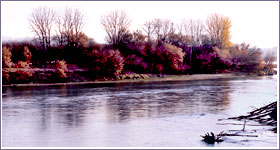
Tribal Chairman Gary Aitken's job is to help the Kootenais
|
By Morgan Winsor Kootenai
tribal elders have strived to pass on the history and spirituality
of the tribe’s birth. They teach this first by reciting the
Covenant they have with the Creator: |
In 1989, Aitken’s brainchild became a reality when the Kootenai Tribe contracted with the Bonneville Power Administration to fund construction of a sturgeon hatchery program. Today, the hatchery has a 90 percent success rate of boosting the prehistoric sturgeon population in the Kootenai River. "I thought, ‘one goal down and several to go,’" Aitken said. With the hatchery program gaining success, Aitken decided to return to his political roots. After being reelected to serve on the Kootenai Tribal Council six years ago, Aitken sunk his teeth into another project. This time it was all about strengthening his tribe’s economy. In 1996, Aitken guided the tribe into signing a pact with the state of Idaho to open the Kootenai Casino. Two small, circus-size rooms were built next to the 56-room Kootenai River Inn. The hotel – a branch of the Best Western hotel chain – sits on tribal land and overlooks the Kootenai River. "Sometimes, usually during the evening, we walk out on one of the hotel room balconies and watch for sturgeon. Not long ago we saw a huge one (adult sturgeon) rolling over and over, splashing on top of the water," Aitken said, pointing to a distant embankment.
Three years ago, the Kootenai Tribal School opened its doors. The three-classroom facility provides education for about three-dozen students in kindergarten through 12th grade. "It’s really a lot of fun teaching here," said 22-year-old Carmen Barnes, who recently graduated from the University of New Mexico and returned to the reservation to spend time with her family and teach at the school. "Gary is great, the staff here is supportive and the students really appreciate the special attention they receive." Because the tribe is small – about 160 members – the staff at the tribal school includes three teachers, a counselor, a teacher’s aide, a language teacher, a general assistant, a cultural teacher and an administrator. Aitken said tribal elders often volunteer their time to teach the students the original Kootenai language. The school provides academic training under the same guidelines as the Idaho State Board of Education, Aitken said. "It’s been a great success," Aitken said. With the sturgeon population rising, the casino raking in revenue and the tribal school educating youngsters, Aitken said there are many "future projects still up in the air." "But that’s another story," he said. As for now, Aitken said politics take up most of his time. If not trying to spend quality time with his wife, Linda, son Gary Jr., and daughter Amethyst, Aitken said "you’ll probably find me at tribal council headquarters." As for retirement for Aitken: "Not anytime soon, but you can bet that when I do retire, I’ll be back taking care of our fish, maybe I’ll become a pond scrubber or something But for right now, my job is to help the tribe." |
||||||||
|
|||||||||

